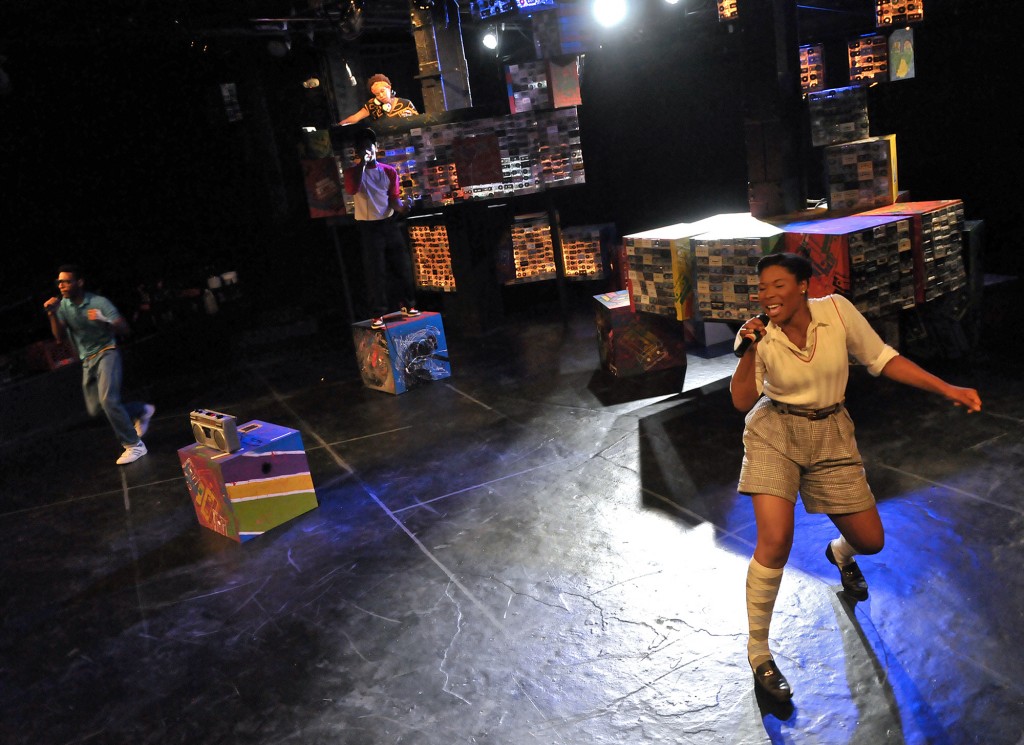Theater Review: “How We Got On” — Exhilarating Hip Hop
I am probably the last person anyone would see as a hip hop fan, but I walked out of the theater with a new appreciation for the music and the satisfaction of experiencing an old-fashioned coming-of-age story told in a refreshing new way.
How We Got On by Idris Goodwin. Directed by Summer L. Williams. Staged by Company One at the Plaza Theatre. At the Boston Center for the Arts, Boston, MA, through August 17.
By Terry Byrne
How We Got On is poetry in motion. Playwright Idris Goodwin combines old-school storytelling with a flawless blend of rhythm and rhyme to serve up a bit of hip hop history wrapped in a heartfelt yarn of moving from adolescence to maturity.
But no matter how clever Goodwin’s raps are, they would be nothing without the graceful guidance of director Summer Williams in this New England premiere. In this Company One production, Williams not only keeps the action running smoothly, she elicits phenomenally unselfconscious performances from Kadahj Bennett and Jared Brown as the story’s two protagonists and Cloteal Horne as the girl who encourages the boys to “breathe in joy.”
How We Got On brings a delightful mix of sound, light, staging, and movement to this tale of two teens trapped in the no man’s land of Midwestern suburbia. Without getting too bogged down in adolescent angst, Goodwin explores teens who hope to defy the expectations of their families and peers and make their way to the world of Yo! MTV Raps.
Hovering over the action of the play is the Selector (Miranda Craigwell), who sets the scene for us in the summer of 1988 when rap was establishing its foothold in the music industry and the culture at large. Our narrator and sometime teacher—explaining idioms and period references—the Selector is a smooth operator who also morphs into each of the teens’ distinctly different dads.
The plot follows the smart poet Hank (Bennett) and the charismatic performer Julian (Brown), each of whom need the other in order to succeed at creating “the spirit, the body and the voice” necessary to tell their story through rap. As the Selector casts the ‘80s spell through musical clips and historical facts, Bennett and Brown mesmerize us. Their performances are not only about delivering exciting, powerful hip hop poetry, offered with effortless joy and energy, but also about evoking the vulnerability of teens who are trying, and not always succeeding, to make something their own.
Dramatist Goodwin takes his time finding common ground between these two young men, and as Hank and Julian edge toward a sense of trust and understanding, so does the audience. When the focus is on Hank and Julian’s development as artists and young men, the play soars.

Kadahj Bennett, Miranda Craigwell, and Cloteal Horne in the Company One production of HOW WE GOT ON. Photo: Craig Bailey.
As a kind of counterbalance to the boy bonding, Goodwin introduces Luann, the wealthy daughter of a professional basketball player who isn’t taken seriously as a rapper until Hank witnesses her improvisational rhyming skills. While Luann’s character remains a bit of a third wheel in the play, Horne is so dynamic she pulls us right into Luann’s magic and makes us believe she can take the rappers to higher creative level (literally and figuratively).
Janie E. Howland’s abstract set includes cubes decorated with cassettes, backlit by James McNamara, and given a beat of their own by the partnership of McNamara and sound designer Edward Young. The squares of cassettes are specific images, but they also suggest larger shapes that the audience’s imagination can metamorphose with ease: a mall parking lot, a water tower, a basketball court.
I am probably the last person anyone would see as a hip hop fan, but Goodwin builds such a compelling argument and believable characters that I walked out of the theater with a new appreciation for the music and the satisfaction of experiencing an old-fashioned coming-of-age story told in a refreshing, new way.

